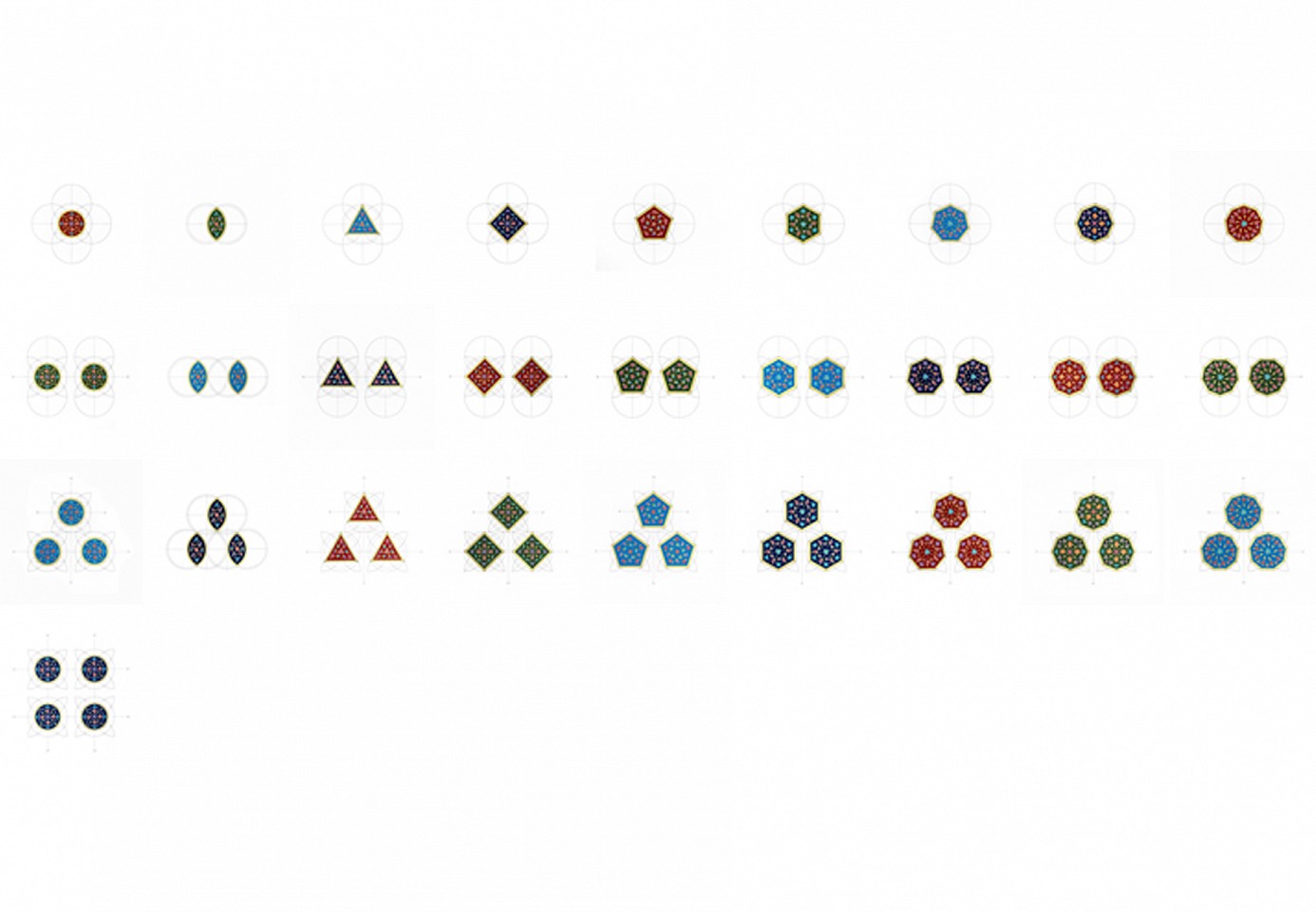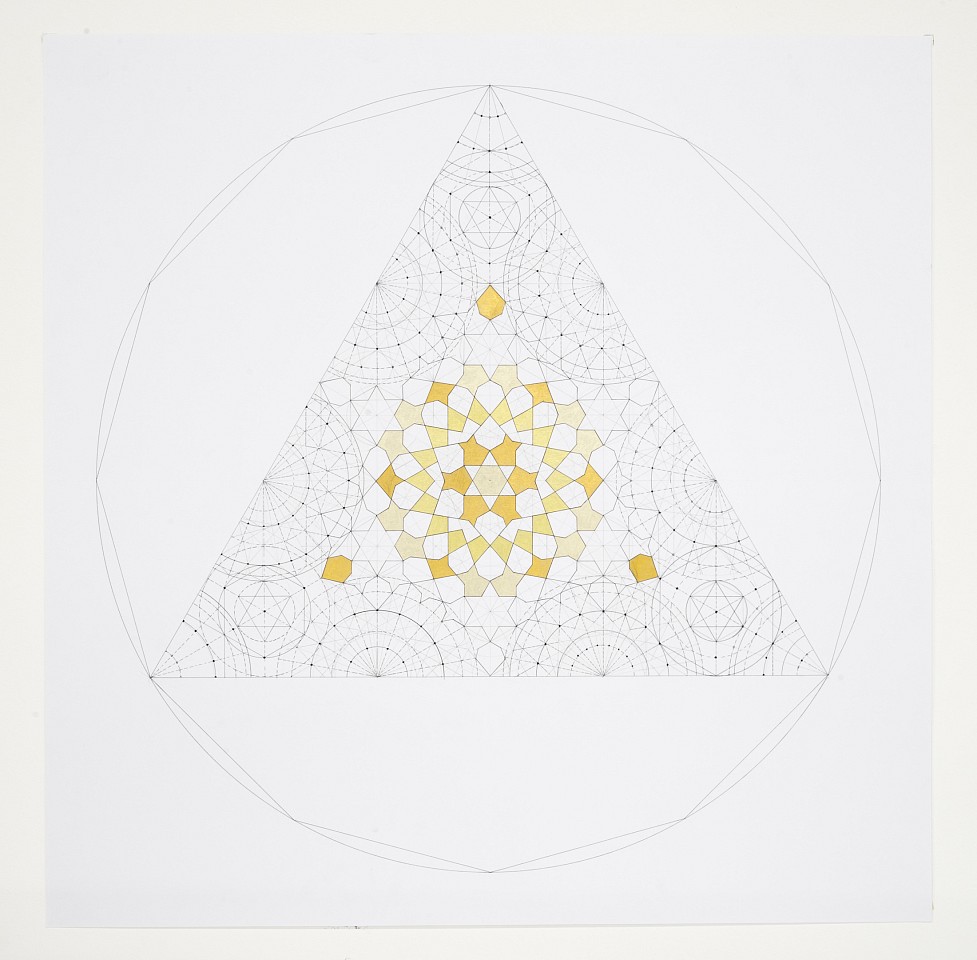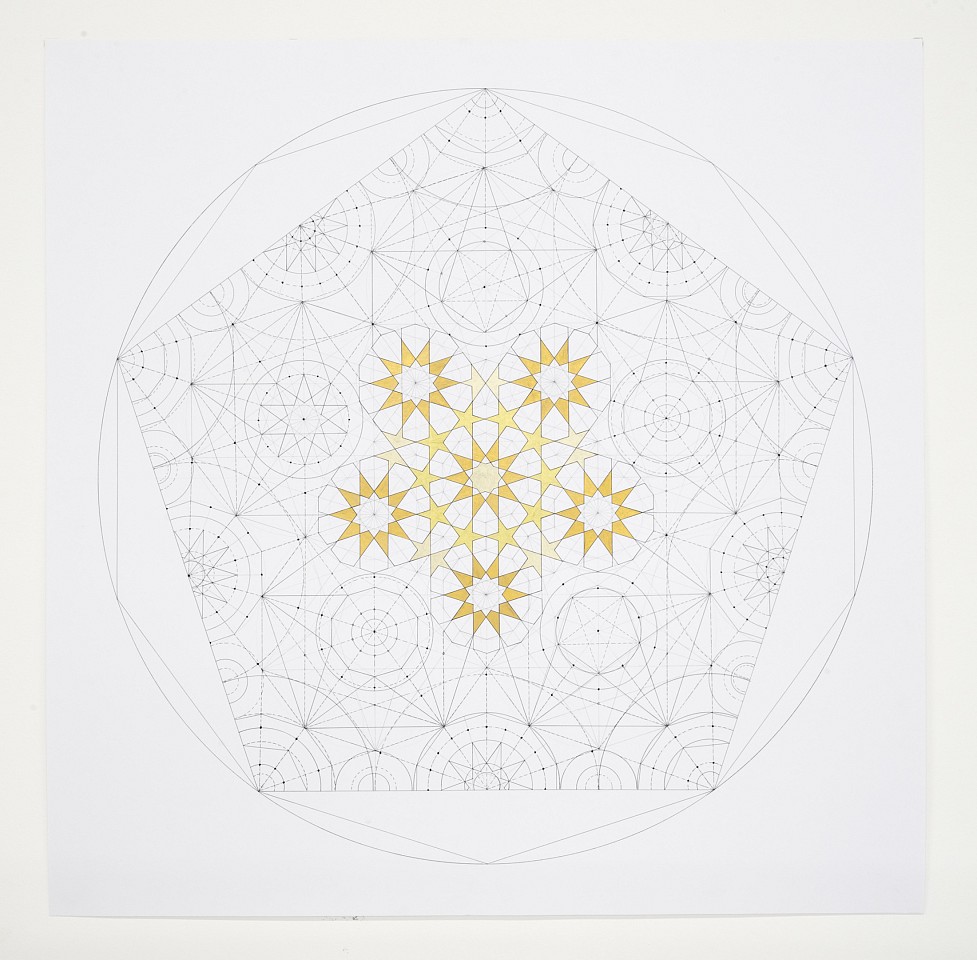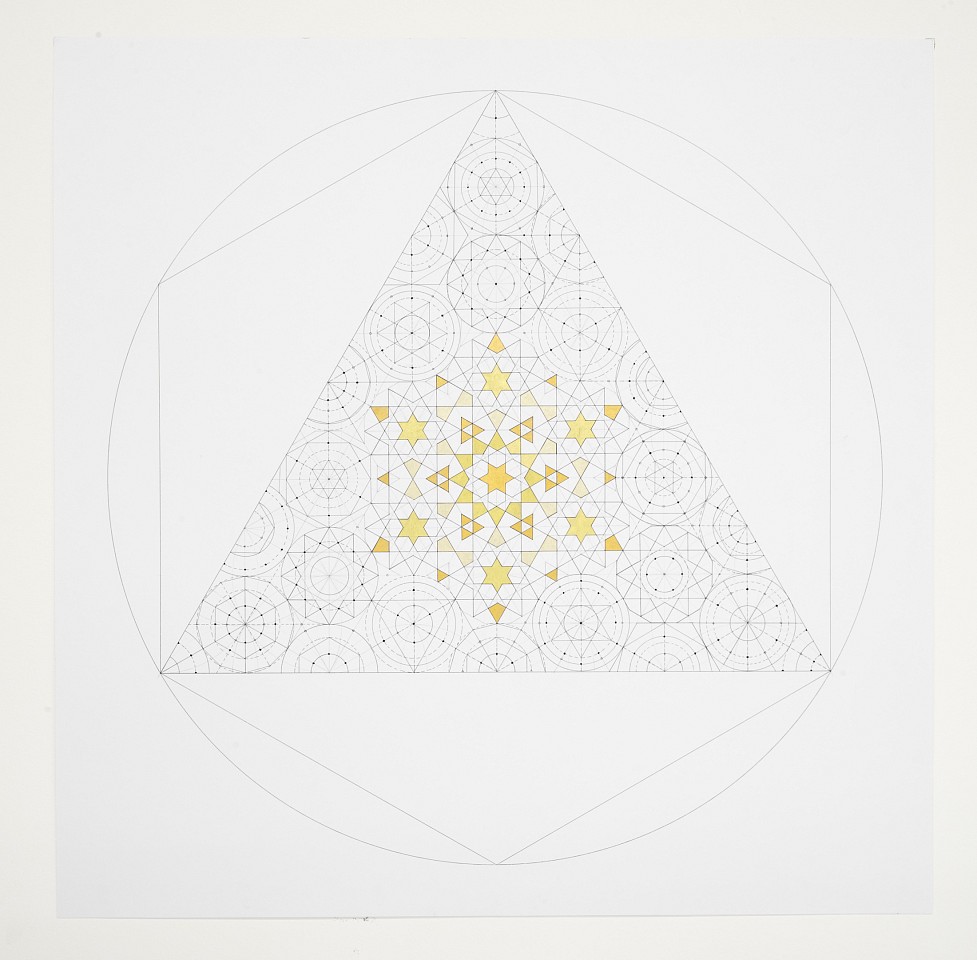Dana Awartani
Abjad Hawaz series, 2016
Shell gold, ink and gouache on paper
Dana Awartani
Dodecahedron Within a Icosahedron from The Platonic Solid Duals Series, 2016
Shell gold and gouache on paper
54 x 54 cm
Dana Awartani
Dodecahedron Within a Icosahedron from The Platonic Solid Duals Series, 2016
Shell gold and gouache on paper
54 x 54 cm
Dana Awartani
Octahedron Within a Cube from The Platonic Solid Duals Series, 2016
Shell gold and ink on paper
DAN0114




Through highly studied, focussed, and skilled deployment of traditional techniques, Dana Awartani extends interpretive legacies. She masters historic and symbolic playgrounds to explore and sustain revered structural traditions. Her innovative approach to these visual codes is epitomised by her Abjad Hawaz concept. Through it, she evolves and maps the complexities of Sufi and Islamic scholarly traditions, opening up contemporary spaces for intuitive comprehension of linguistic and semantic systems, revivifying their potent potential for spiritual engagement.
She works within the Sufi tradition where symbolism is an essential means to approach and intuit awareness of the Eternal. Sufi poetry and teachings are layered with evocative symbols that strive to inform and awaken different levels of intellect, being, and understanding. Transcending strict narrative structures, the texts are steeped in complex sign systems manifested through literary devices such as double-entendre, root-word resonance and numerology.
The traditions Awartani inherits from have their legacies in more ancient practices: the Islamic world was heir to an alphabetical numerology that had been in play for many centuries. In this system, each letter of the alphabet can be alternatively expressed by a number. A common practice in Arabia, letters would naturally be read simultaneously as words and as a collection of numbers. Within this context, the miracle of the Quran is made further evident through the eloquent and highly complex manifestation of such intricate numerological systems.
The study of abjad, particularly its exceptional rendering in the scripture, is part of a great scholarly tradition called the science of letters (ilm al-huruf). Concerned not only with numerological systems, scholars of this science also investigate letter shapes and forms, as well as their cosmological significance. The science of numbers stands above nature as a way to approach a comprehension of unity or ‘tawhid’, an absolute central principle of Islam pertaining to the indivisible oneness of God. In this vein, numbers are the principle of beings and the root of all sciences, the first effusion of spirit upon soul, whereas geometry is the expression of the ‘personality’ of numbers.
It is within this rich reverential legacy that Awartani evolves Abjad Hawaz, a singular system of visual coding that draws on her deep understanding of geometry and illumination. She builds upon the ancient numerical system, expansively divining an aesthetic language that revivifies the abjad and insists on its relevance. This visual language possesses a striking immediacy in its capacity to extrapolate symbiotic meanings and forms. This is a co-dependency inherent in geometry where the form is the result of a numerical expression – without which geometry would not exist. Skillfully deploying her deep understanding of traditional geometric expressions, Awartani abstracts and imparts pure meaning using the method to create a harmonious and formal expression of complex notions that are difficult to succinctly synthesise.
Awartani’s visual language invites the viewer to participate in its coding and meaning-making, the direct translation of number into form becoming decipherable even for the uninitiated. In the system, each shape’s angles and repetitions equate to the numerical value or sum of the individual letter. So, as we engage with the form, the sense of the system emerges – we see that alef is not only shaped like the number one but is the number one. From here, a further kind of comprehension grows, with historic, scientific and mathematical symbolism potently coalescing as they are woven into the invested values of Awartani’s focussed expression. Understanding expands and we are able to appreciate alef as the original letter, the representative of the principle of unitary being. Accordingly, Awartani achieves a concurrent expression of this number, letter, and concept with a circle – the symbol of unity and creation. The other letters of the alphabet are said to have evolved from the letter alef into the variety and multiplicity of the alphabet, which for the hurufis, represents the cosmos. In the geometric tradition, the circle is the creator and originator of all geometry, where every design starts and finished within the circle.
A highly trained practitioner of traditional Islamic arts, Awartani deploys skilled techniques from within ancient systems. In this way, she engages with the systems in their most essential form, tapping their invested power to bring it into a contemporary moment. Through these pure interrogations, Awartani invigorates the traditional, mapping and deconstructing value to demonstrate the potential and enduring relevance of a highly powerful visual language capable of concurrently articulating deep truths of mathematics, science, history, and spirituality. As such, her work becomes a vigorous rebuttal that counters the uninformed perspectives that dismiss these practices merely as a decorative art
or ‘craft’.
NEW YORK, NEW YORK (April 10, 2017) —The Institute of Arab and Islamic Art (IAIA) announces its inaugural show, EXHIBITION 1, a group exhibition featuring works on paper and prints by Dana Awartani, Monir Shahroudy Farmanfarmaian, Zarina Hashmi, and Nasreen Mohamedi. EXHIBITION 1 seeks to examine how architecture—and its geometries—enters an artist’s consciousness, their vocabularies, and, in turn, their work.
With upbringings in Saudi Arabia, Iran, India and Pakistan, the artists in EXHIBITION 1 share the experience of living with Islamic architecture despite originating in vastly different places and environments and leading vastly different lives. How do we respond to the spaces we have experienced and how does that compare to the way we remember them? When memories are recollected, how are they told? How much do history, nostalgia, self-exile and solitude impact the way we visualize our memories? How and when do we share them?
Whilst the buildings that make up our architectural heritage often remain untouched throughout time, our individual personalities shape the way we perceive them, resulting in a diverse range of expressions. This exhibition explores these artists’ relationship to geometry within their respective vocabulary.
EXHIBITION 1 will present 12-16 significant works on paper and prints from each artist. The exhibition will take place at 3 Howard Street.












